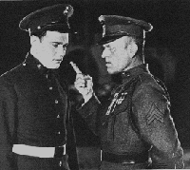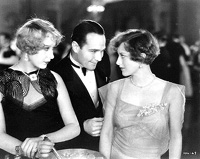|
Jesse Monteagudo’s
Book Nook
|
|
Wisecracker:
The Life and Times of William Haines, Hollywood’s First Openly Gay Star,
by William J. Mann; Viking, 444 pages; $29.95.
William
Haines is one of Hollywood's untold stories. Our number one box-office
draw in 1930, Haines's career as a movie star ended by 1934. Today Haines
is barely mentioned in studies of Tinsel Town or the cinema, and videos
of his films are almost impossible to find.
|
Outside of an hysterical
chapter in Kenneth Anger's Hollywood Babylon II, very little has been written
about the man who was at the top of two consecutive careers while remaining
true to himself. William J. Mann, journalist and author of last year's
novel The Men from the Boys, makes up for all this with Wisecracker: The
Life and Times of William Haines, Hollywood's First Openly Gay Star.
Born on New Year's Day 1900,
Staunton Virginia's second claim to fame (after President Woodrow Wilson)
lived the gay life in New York's Greenwich Village before he was "discovered"
by Goldwyn studios in 1923and sent to Hollywood. There he became part of
a thriving film colony where an easy bisexuality was the norm - even the
super straight Clark Gable had a fling with our hero.
|
 |
William
Haines (l) & Lon Chaney (r)
In
MGM 1927 classic "Tell It To the Marines"
|
Not much of an actor, Haines
enjoyed the star's life, hobnobbing in and out bed with the likes of Ramon
Novarro, Cary Grant, George Cukor and Joan Crawford, who became his life-long
pal. Problems with the law were taken care of by the complacent studios.
It was at this time that Haines got the reputation as a "wisecracker";
making smart remarks in order to hide the truth from his fans and the press.
This idyll ended with the
Great Depression, talking pictures and the rise of pressure groups like
the Legion of Decency. Stars on the rise like Grant and Gary Cooper gave
up their male lovers and took up wives, in order to present an image more
pleasing to Middle America. Though Haines's homosexuality might have been
tolerated under ordinary circumstances, his open marriage (in both senses
of the word) with Jimmie Shields upset MGM boss Louis B. Mayer's puritan
sensibilities. By 1934,Haines was out of a job, replaced by straight arrow
types like Robert Montgomery (Elizabeth's dad) and the by-now convincingly
straight Mr. Gable.
Happily Billy Haines's life
did not sink into a pit of alcoholism and self-hatred, as did the hapless
Novarro. Using his native good taste and Hollywood contacts, Haines rebuilt
his life as Tinsel Town's most distinguished interior designer.
 |
William
Haines and Joan Crawford
in
MGM's 1927 classic "West Point"
|
Here, again, Haines was
at the top of his profession; movie stars, after all, come and go while
a good decorator is hard to find. Not even a 1936 incident in Manhattan
Beach, in which a mob attacked Haines and Shields after they allegedly
molested a local boy, was able to faze our hero, or cramp his style. Haines
continued to be part of Hollywood's gay crowd and lead a life of devotion
and domesticity (if not monogamy) with his spouse Jimmie Shields. "Uncle
Willie and Uncle Jimmie have the happiest marriage in Hollywood," Crawford
told her daughter, Christina.
|
Billy and Jimmie lived together
from 1926 until Haines died from cancer in 1973. Distraught by his lover's
death, Shields took his own life two months later. For Wisecracker Mann
interviewed Haines's surviving relatives, colleagues, friends and acquaintances;
from silent film star Anita Page - the only woman Haines ever proposed
to - to Nancy Reagan (a client), veteran gay activist Harry Hay and the
now-aged Jimmy Walker, the boy at the center of the Manhattan Beach incident.
Mann tells us too little
about the inner workings of the Haines-Shields marriage - Shields apparently
kept house while Haines apparently kept Shields - a near-impossible task
since both principals are now dead. Mann is more successful in his depictions
of gay life in Hollywood, dropping names of movie stars who were gay, bisexual
or dubious. Contrary to Mann's firm belief, Cary Grant's strict homosexuality
is still in doubt, and his speculations about the likes of Jack Benny and
Vincent Price are just that.
| Still, it is fun to read
tales about the 1929 opening of Jimmy's Backyard, Hollywood's first "exclusively
gay" bar; the gay parties thrown by George Cukor and Cole Porter in the
thirties; or the recollections of Haines's protege Ted Graber, whose long-term
relationship with Arch Case is one that's as long as the one between Haines
and Shields. |
 |
l-r
Gwen Lee, William Haines and Joan Crawford
1929 - MGM: " The Duke Steps Out"
|
I am a sucker for movie star
books, even when they try to hide or explain away their subjects' sexuality.
Wisecracker plays no such games, for it is as honest as its hero. If we
are lucky, Mann's book will move the powers-that-be to make Billy Haines's
old movies available once again in video form. At least it has people talking,
as they did on National Public Radio, about "Hollywood's first openly gay
star."
|